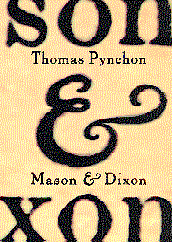Larry Daw’s Review of “Mason & Dixon”
- At January 12, 2021
- By Spermatikos Logos
- In Pynchon, The Modern Word
 0
0

Review by Dr Larry Daw
At first, it all seems very simple. An historical novel about two Englishmen of singular importance to American history, written in a meticulous eighteenth-century prose style replete with idiosyncratic mannerist capitalizations, by a writer eminently qualified to research and prepare convincing historical representations. Thomas Pynchon is, after all, a well-established master of the Baedeker, the Fausto-ian history of Malta, the intricacies of the new Turkic Alphabet and the Thurn und Taxis postal system, the film schools of both pre-war Germany and a recently psychedelic California, the progress of Oriental, Kabbalistic, and Karmic philosophies, and the emergence of Catatonic Expressionism!
In Mason & Dixon, Pynchonian History, and all the attention it warrants, provides us with the continuity we have come to expect in the writing, as much as we crave the incisive descriptions of paranoia and anti-paranoia. So, we are not surprised to find both in Mason & Dixon. The ancestor of the perennially debauched “Pig” Bodine appears as the equally raucous “Fender-belly” Bodine. Vast political intrigues provide us with ample paranoia as Mason seeks the patronage of the Royal Astronomer Bradley via the duplicitous Maskelyne, and both Mason and Dixon repeatedly wonder if their duties as observers of the heavens and surveyors of the earth are entirely subservient to the interests of the French, English, and Dutch naval powers which, in turn, represent the implacable bureaucracies of slavery, religion, nationhood, and oligarchy. The concept of Family and the concept of Duty are made cruelly incompatible in this world, and the daily lives of the populace of several different lands are frequently interrupted by the interdiction of ghosts or, more generally, of inhabitants of a very familiar Pynchonian region known as the Other Side. . . . Even the powerful, often-noted opposition between North and South gets its due. In short, Mason & Dixon is at first glance everything a Pynchon novel should be. Both history and paranoid speculation abound.
But, in the final analysis, Mason & Dixon comes across as something like a 24 year old housecleaning –much like going through the pockets of James Joyce and coming up with wads and wads of notes for research projects which were never quite finished. Pynchon’s new novel is like a gigantic, seductive paradigm which was somehow never completed convincingly, a marvellous but ultimately empty theoretical construct which ironically took as its subject the ubiquitous Pynchonian theme of failed paradigms!
A famous Pynchon question asks us: “what are the Stars but points in the body of God where we insert the healing needles of our desire and longing?” Mason & Dixon plays on the idea mightily by re-iterating the famous idea “as above; so below.” In brief, the novel is an attempt to map out the aetherial contours of the noumenal in the multiplicity of the phenomenal. It is geomancy in a terrifically refined sense, a quest to show the world as contained within a vast set of force-lines which are magnetick and telepathick, and yet more-than-magnetick, more-than-telepathick.
The energies of the Dragon, Sha, are described by a Feng Shui master who is an enemy of all the right-angles, great circles, and tangents which are so necessary to the surveying of the Mason/Dixon line. The power of Ley lines crisscrossing the Salisbury Plain and its psychic nexus, Stonehenge, receive detailed treatments. North American Indian burial mounds are mapped out along patterns of power and communication, and the energy of their Warrior Path truncates the progress of the Englishmen’s paltry property line. A mechanical duck races at otherworldly speeds unerringly straight along topographic vectors which have somehow caused chickens to line up like the needles of compasses and receives erotic pleasure from its journeys. Secret Jesuit fraternities use an aura of force and energy to experiment with communication and levitation. Pynchon’s paradigm would become the map of a world which interpenetrates the Heavens seamlessly, as easily as the knotted cords of a fishing-net pass through the very sea which it trolls. But it just doesn’t work.
Perhaps it is simply weak characterization, far too many digressions into pet subjects, a failure to exploit readily available oppositions like slavery and abolitionism, an unconvincing reliance on the convenient appearance of various mystics, oddballs, and historical figures like Franklin, Emerson, Johnson, and Boswell, too many bad bawdy songs, or a sheer inability on the part of an older writer to draw together the fruits of almost a quarter century of research; but the paradigm just does not stick. The paint does not adhere to the canvas, and although we are charmed by wit and a supremely well-chosen idiomatic language which is so deliciously appropriate to any number of finely delineated subjects we can scarcely believe it, Pynchon just does not pull the web of spidery lines which comprise his map of the world and the Universe which surrounds it together in a convincing manner.
Amazing try, but. . . .
Author: Dr Larry Daw
Last Modified: 17 June 1997
Back to: Mason & Dixon Page
Main Pynchon Page: Spermatikos Logos
Contact: quail(at)shipwrecklibrary(dot)com
Last Modified: 17 June 1997
Back to: Mason & Dixon Page
Main Pynchon Page: Spermatikos Logos
Contact: quail(at)shipwrecklibrary(dot)com
